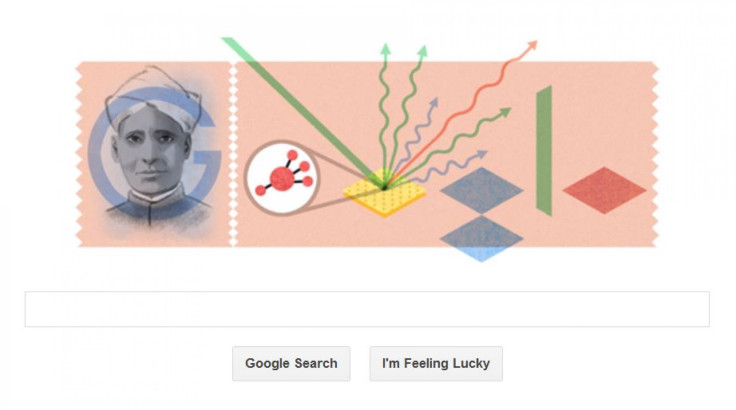CV Raman’s 125th Birthday: Google Honors Nobel Laureate Indian Physicist With Doodle Highlighting The ‘Raman Effect’

Google (NASDAQ:GOOG) devoted a doodle to CV Raman, one of India’s most prominent scientists, on his 125th birthday, which falls on Thursday. The doodle on the search engine giant’s India home page highlighted Raman’s work, for which he won the prestigious Nobel Prize.
Thursday’s Google Doodle shows Sir Chandrasekhara Venkata Raman’s (his full name) face behind the letter “G” while other letters in the logo demonstrate the “Raman effect,” a phenomenon discovered by Raman in 1928. He was the recipient of the Nobel Prize in Physics in 1930 for the discovery, and became the second Indian Nobel laureate after Rabindranath Tagore, who received the Nobel Prize for Literature in 1913.
Here is how the Encyclopedia Britannica defines the “Raman effect:"
“When a beam of light traverses a dust-free, transparent sample of a chemical compound, a small fraction of the light emerges in directions other than that of the incident (incoming) beam. Most of this scattered light is of unchanged wavelength. A small part, however, has wavelengths different from that of the incident light; its presence is a result of the Raman effect.”
Born on Nov. 7, 1888 in Trichinopoly in the erstwhile Madras Presidency in British India (now known as Tiruchirappalli in the southeastern state of Tamil Nadu), Raman entered college in 1902 at the age of 13 and graduated in 1904 with a gold medal in physics.
After graduating from the Presidency College in Madras (present-day Chennai) with a master's degree in physics in 1907 at the age of 19, Raman joined government service as an accountant, and in 1917, he became a professor of physics at the University of Calcutta (present-day Kolkata) in the northeastern state of West Bengal.
In 1924, Raman was elected a Fellow of the Royal Society and was conferred with a knighthood by the British monarch in 1929. He, along with Suri Bhagavantam, another noted Indian scientist, discovered the quantum photon spin in 1932, which further confirmed the quantum nature of light.
Raman also studied the acoustics of musical instruments and worked out a theory of transverse vibration of bowed strings, on the basis of superposition velocities.
In 1933, Raman joined the Indian Institute of Science, or IISc, in Bangalore as its first Indian director. He also started a company called Travancore Chemical and Manufacturing Co. Ltd., currently known as TCM Limited, which manufactured potassium chlorate for use in the match industry.
Raman retired from IISc in 1944 and established the Raman Research Institute in Bangalore the next year. In 1947, he was appointed as the first National Professor by the new government of independent India, and was awarded the Bharat Ratna -- India's highest civilian award -- in 1954.
On Nov. 21, 1970, Raman passed away from natural causes in Bangalore. India celebrates National Science Day on Feb. 28 every year to honor the discovery of the Raman effect.
© Copyright IBTimes 2024. All rights reserved.












